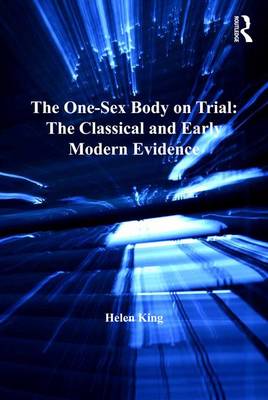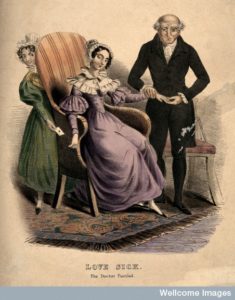By Helen King (Regular Contributor)
As Valentine’s Day approaches, now may be the time to check yourself out for a very nasty condition: lovesickness. Are you looking pale? Sleeping badly? Finding it difficult to concentrate? Sighing a lot? Are you off your food? These symptoms, history tells us, may point to lovesickness as your problem.
When is love a disease?
The first stages of being in love, or loving someone who is unavailable, can lead to some physical sensations which in other contexts we’d associate with disease, so perhaps it isn’t surprising that love itself could be understood as a disease. Here’s the character Philetas, in Longus’ novel Daphnis and Chloe, describing his experience: ‘I could not think of food or take drink or get sleep … No, there is no remedy for love, nothing to drink or eat or chant in songs, except kissing, embracing and lying down together with naked bodies.’ Or, from the western medical tradition which drew on the ancient world, here’s Battista Fregoso in his L’anteros ou contramours of 1581: love ‘is not merely behaviour resembling sickness, but it is a true disease, virulent and dangerous’.
But we’re getting ahead of ourselves here. Before we reach the cure, how does the process of cause and effect work? In more recent history, emotions rather than humors have been thought to influence the body. In 1803 the Edinburgh Practice of Physic, Surgery and Midwifery told its readers that ‘love and other passions of the mind’ cause chlorosis, the ‘green sickness’, which was classed here as being the same as ‘chlorosis amatoria’. Strong emotions affected the body and could lead to insufficient menstrual blood being produced by women. Lovesickness and – if it was seen as a separate condition – chlorosis too could be regarded as due to humoral imbalance. This in turn could be traced back to the brain, for Galenic theory the seat of the passions. One way of avoiding the condition was to control the input to the brain: as Jacques Ferrand wrote in his A Treatise on Lovesickness, first published in 1610, ‘Because this carnal love makes its attack upon the brain (the divine fortress of Pallas [Athene]) by the windows of the eyes, you must make sure that no inciting object happens to come into view’.
Who suffers from lovesickness?
In ancient Greek and Roman medicine, both men and women could be affected. If the beloved does ‘come into view’ then, as many physicians from Galen onwards observed, the pulse of the sufferer will speed up. Galen proudly told the story of his diagnosis of the wife of the noble Justus, sick with love for a dancer called Pylades, by feeling her pulse when his name was mentioned. Other stories involved young men whose love for inappropriate love objects – the stepmother or their father’s concubine! – led to serious illness, only detected by a clever physician. Stories of successfully diagnosing a young man suffering from unrequited love were told of Hippocrates and Erasistratus, as well as featuring in Galen.
In her book Lovesickness in the Middle Ages, Mary Wack showed how in this period the condition came to be focused on men rather than on women. Eros, erotic love, was seen as being linked to heroicus, that which belongs to a lord or nobleman. This made it a lot more respectable to be madly in love – it was almost a mark of having the wealth and leisure to indulge yourself in this way!
In humoral medicine, those who were dominated by black bile were thought most likely to suffer from lovesickness. As well as chlorosis, other conditions that formed part of ancient, medieval or Renaissance medicine were believed to overlap with lovesickness; for example, uterine fury and satyriasis. One thing that made it very important to know just which of these was the problem was the question of the best cure.
Getting better
Untreated, lovesickness could lead to death. One problem was that the sufferer may not even want to get better, and without the cooperation of the patient there was little hope. According to Ferrand, all three aspects of healing – diet, drugs and surgery – could make a difference.
By avoiding wine in favor of water, and adopting a cooling diet (lots of sorrel, endives, chicory and lettuce) with nothing spicy or salted, while taking plenty of exercise, Ferrand believed that the symptoms could be alleviated. Kissing and groping should be avoided entirely, but attending a criminal trial or hearing a hellfire sermon could be beneficial. Sleeping on one’s back is very bad as it overheats the kidneys. As for drugs, Ferrand recommended cooling and moistening enemas. Bloodletting could help, using the hepatic vein in the right arm, or in more serious cases the median vein.
Ultimately, however, the one guaranteed cure was to ‘enjoy’ the person who had caused the condition; provided that this was permitted, which would be a problem if the sufferer or the beloved was already married. However, Ferrand notes that sometimes just dreaming about this consummation would suffice! Happy dreaming…
References:
J. Ferrand, A Treatise on Lovesickness (tr. and ed. D.A Beecher and M. Ciavolella, Syracuse University Press, 1990)
M. Wack, Lovesickness in the Middle Ages: The Viaticum and its commentaries (Philadelphia: University of Pennsylvania Press, 1990)
Emotions and disease (National Library of Medicine)


Helen King enjoys sharing ideas about the history of the body and of medicine, whether that means teaching school students on a ‘Roman Medicine’ themed day, lecturing surrounded by body parts in jars at the Bart’s Pathology Museum, or talking to heart surgeons at the Royal Galleries at Holyroodhouse. Her most recent book is The One-Sex Body on Trial: The Classical and Early Modern Evidence (Ashgate, 2013) and, as part of her commitment to distance learning, she has written a MOOC on ‘Health and Wellness in the Ancient World’.

